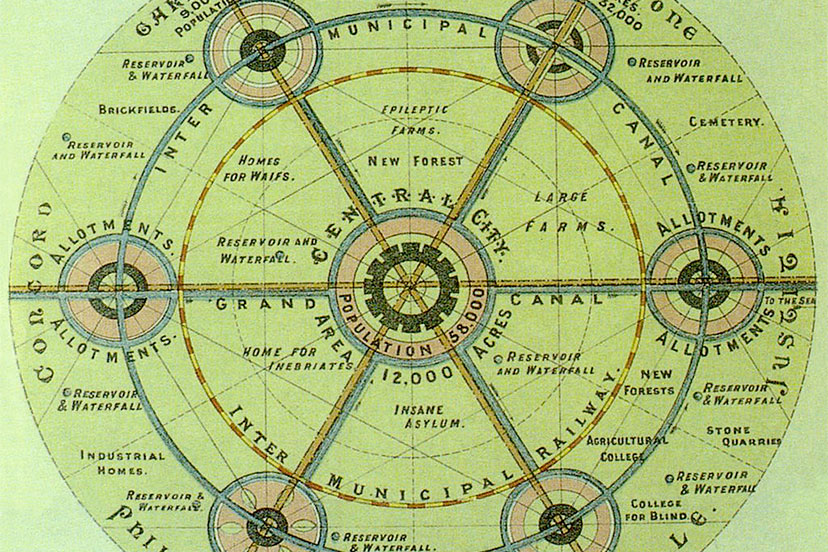Money, it is often said, is “a drug in the market.” Like labour itself, it seems enchanted, and thus one sees millions in gold and silver lying idle, in banks facing the very streets where men are wandering workless and penniless…
— from “Garden Cities of To-Morrow” by Ebenezer Howard, originally published in London in 1898 with the title, “To-Morrow: A Peaceful Path to Real Reform”.
It was a modest book, only about 150 pages, with a few colorful illustrations. But it ruined my life. And yours as well.
And like the other things that are ruining our lives, Mr. Howard’s ‘Garden Cities’ proposal seemed so harmless at first.
“Build a few Garden Cities according to my Plan,” he essentially told us, “and then, completely rebuild the City of London. And everything will be hunky-dory.” (He never actually used the term ‘hunky-dory’, but I’ve always wanted to use it myself, in a humor article, and now I have.)
It started with ‘magnets’. People were generally enthralled with magnets, back in 1898. Everyone had two or three magnets knocking around the house, unless they happened to be men wandering workless and penniless on the very streets that banks were facing. But even the workless and penniless men thought magnets were amazing.
So Mr. Howard took advantage of this popularity to illustrate what was wrong with England, using this illustration of three magnets:
Back in 1898, as we can see from this drawing, The People were a rectangular piece of iron, surrounded by three magnets. Where will they go? We obviously assume they need to go somewhere, because like people everywhere who resemble a rectangular piece of iron, the people in England were unhappy with wherever they happened to live, and wanted to live somewhere else.
One magnet was the Town, with its attractions — high money wages, places of amusement, social opportunity, well-lit streets — balanced by a whole lot of negatives — foul air, murky skies, high rents, high prices, isolation in the midst of crowds. Slums, too, and ‘Gin Palaces’. Mr. Howard was here referencing London and numerous other British cities and towns that were plagued, in the late 1800s, by filth, unemployment, and misery.
Another magnet was the Country, with its attractions — beauty of nature, fresh air, clean water, low rents, sunshine — and its downsides — long hours at low wages, lack of amusements, crowded dwellings, lack of opportunities for socializing. (Sounds a bit like Pagosa Springs, except we don’t have low rents.) England at this time still had lots of miserable people living in miserable farming communities, wishing to heaven they could be elsewhere.
But Mr. Howard believed a third magnet could be created. ‘Town-Country.’ The best of both worlds. All the advantages, and none of the disadvantages.
This particular magnet didn’t exist in 1898, except in Mr. Howard’s imagination, but if it had existed, it would have been Paradise. Compared to London, at least.
Nature. Social opportunities. Low rents. High wages. Pure air and water. Freedom and co-operation. Luckily, Mr. Howard was able to make a drawing of his ideal town-country, which — in his imagination — consisted of a closely-aligned group of seven “towns” full of homes, manufacturing enterprises, and shopping opportunities, surrounded by generous expanses of agricultural lands, forests, and outlying social establishments such as “Homes for Waifs”.
We can see some wonderful aspects to this concept, although it was not immediately clear how The People, who were shaped like a rectangular piece of iron, would fit into all these circles. Feels a bit like the proverbial square-peg-in-a-round-hole problem. Mr. Howard didn’t provide a solution to that (important?) little snag, but he did provide some of the things everyone wanted in 1898, like an inter-municipal railway, straight (yellow brick) roads connecting the various suburban centers, a “Grand Canal”, an insane asylum — and a home for inebriates, of which there were plenty in England at the time, due to the fact that everyone was disenchanted with their living situation.
The main problem with Mr. Howard’s dream — which entailed the construction of dozens, or hundreds, of these Garden Cities, scattered across the English landscape — is that the dream somehow made its way to America. And to other places.
And it actually came true. But not at all the way Mr. Howard imagined it.
Here, for example, is how the ‘Garden City’ concept played out in the rural landscape of Archuleta County, Colorado.
Like most simplified illustrations, this one leaves certain things out. We left out the skate park, for instance. And the guy who fishes every morning in Village Lake. And the new county jail. Actually, we’ve left out a lot of very important things.
Most importantly, we left out the parking lots. And thousands of cars, bumper to bumper, headed east and west along Highway 160.
These were also things Ebenezer Howard left out of his ‘Garden City’ concept in 1898. Of course, Mr. Howard had no way of knowing that John D. Rockefeller’s Standard Oil Company was already on its way to becoming one of the world’s largest multi-national corporations, and that Henry Ford would revolutionize automobile production, with the famous Model T rolling off the assembly line in 1908.
So instead of Paradise, we ended up living in an automobile-centric, tourist-infested Hell. While the city planners like Mr. Howard were drawing pretty pictures, Mr. Rockefeller and Mr. Ford were working so much harder, to ensure that The People would pave their Garden Cities with asphalt, and poison the air with decomposed hydrocarbons, leaving us all with an overheated atmosphere… and a combustible landscape.
It all seemed so simple, and feasible, in 1898.
But the Garden City went to seed. And we can blame Ebenezer Howard.
Tried to be helpful, and ended up ruining our lives.





